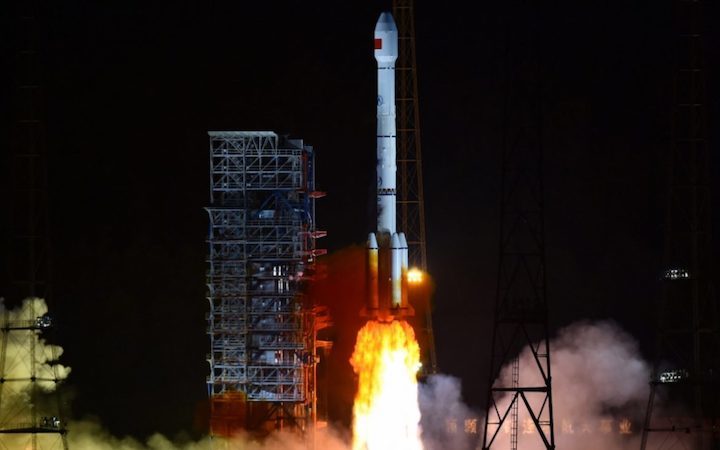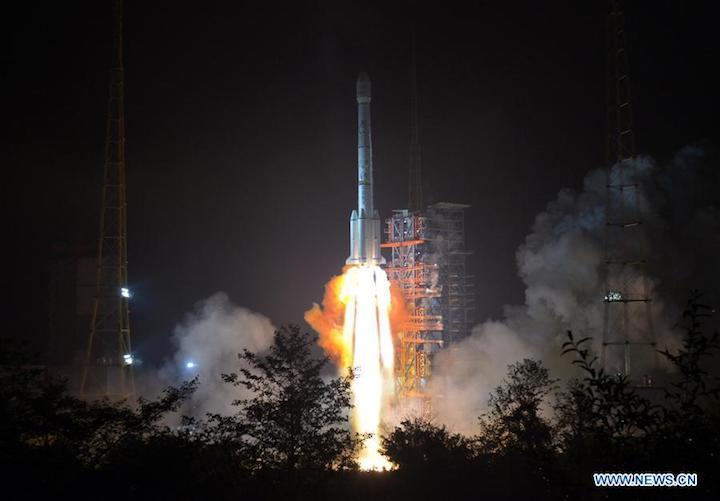4.05.2018

China launched the APStar-6C communications satellite from the Xichang Satellite Launch Center, Sichuan province, using a Long March-3B/G2 ‘Chang Zheng-3B/G2’ launch vehicle on Thursday. Launch took place at 16:06 UTC from the LC2 Launch Complex.
APT entered into the in-orbit delivery contract for the APSTAR-6C satellite with China Great Wall Industry (Hong Kong) Corp. on 17 October 2015. APSTAR-6C is based on CASC DFH-4 platform equipped with 45 transponders in C, Ku, and Ka bands, with a designed service life of 15 years.
The satellite will replace the in-orbit APSTAR-6 satellite in 2018, providing high power transponder services to customers across the Asia-Pacific region for VSAT, video distribution, DTH and cellular backhaul applications.
The DFH-4 (DongFangHong-4) platform is a large telecommunications satellite platform from a new generation that keeps high capability in output power and communication capacity ranking with international advanced satellite platforms.
The applications for the DFH-4 platform aren’t limited to high capacity broadcast communication satellites and can be used for tracking and data relay satellites, regional mobile communication satellites, etc.
The platform comprises propulsion module, service module and solar array. It has a payload capacity of 588 kg and an output power of 10.5 kW by the end of its lifetime. Its design lifetime is 15 years and its reliability by the end of life is more than 0.78. Based on versatility, inheritance, expandability and promptness principles and mature technology, the platform will reach world advanced level to meet the needs of international and domestic large communication satellite markets.
The platform is equipped with 22 Ku-band transponders (four 54MHz and 18 36MHz), 3 receiver antennas, and 2 transmission antennas. With a designed operational life of 15 years, the DFH-4 can support the transmission of 150~200 TV programs simultaneously to ground users using a 0.45m antenna device. The DFH-4 satellite also features strong capabilities against hostile disturbance and jamming. The satellite’s power supply includes two 6m solar panels.
Established in 1980, the China Great Wall Industry Corporation (CGWIC) is a commercial organization authorized by the Chinese government to provide satellites, commercial launch services and to carry out international space cooperation.
As the professional company promoting international cooperation for China’s space industry, CGWIC is devoted to the internationalized development of China’s space industry. CGWIC has developed into a system integrator for space products and services. It can meet customers’ multi-directional needs by providing comprehensive solutions for commercial launch services, satellite export, satellite ground tracking and control station construction, satellite applications, project financing, project insurance and technical training, etc.
Through extensive international cooperation, CGWIC enjoys an excellent reputation in the international aerospace industry, the financial community and the insurance circle.
In addition, CGWIC is actively involved in the international marketing of civilian products and services utilizing space technology and provides high quality products and specialized services in diversified fields including satellite technology applications, green energy, information & electronic products, petroleum & petrochemical equipment, new materials, consulting services, international trade, international exhibition, international logistics, project contracting, international bidding, etc.
To meet demand of international satellite launch market, especially for high power and heavy communications satellites, the development of Long March-3B (Chang Zheng-3B) launch vehicle was started in 1986 on the basis of the fight proven technology of Long March launch vehicles.
Developed from the Chang Zheng-3A, the Chang Zheng-3B is at the moment the most powerful launch vehicle on the Chinese space launch fleet.
The CZ-3B features enlarged launch propellant tanks, improved computer systems, a larger 4.2 meter diameter payload fairing and the addition of four strap-on boosters in the core stage that provide additional help during the first phase of the launch.
The rocket is capable of launching a 11,200 kg satellite to a low Earth orbit or a 5,100 kg cargo to a geosynchronous transfer orbit.

Long March 3B
The CZ-3B/G2 (Enhanced Version) launch vehicle was developed from the CZ-3B with a lengthened first core stage and strap-on boosters, increasing the GTO capacity up to 5,500kg.
On May 14, 2007, the first flight of CZ-3B/G2 was performed successfully, accurately sending the NigcomSat-1 into pre-determined orbit. With the GTO launch capability of 5,500kg, CZ-3B/G2 is dedicated for launching heavy GEO communications satellite.
The rocket structure also combines all sub-systems together and is composed of four strap-on boosters, a first stage, a second stage, a third stage and payload fairing.
The first two stages, as well as the four strap-on boosters, use hypergolic (N2O4/UDMH) fuel while the third stage uses cryogenic (LOX/LH2) fuel. The total length of the CZ-3B is 54.838 meters, with a diameter of 3.35 meters on the core stage and 3.00 meters on the third stage.
On the first stage, the CZ-3B uses a YF-21C engine with a 2,961.6 kN thrust and a specific impulse of 2,556.5 Ns/kg. The first stage diameter is 3.35 m and the stage length is 23.272 m.
Each strap-on booster is equipped with a YF-25 engine with a 740.4 kN thrust and a specific impulse of 2,556.2 Ns/kg. The strap-on booster diameter is 2.25 m and the strap-on booster length is 15.326 m.
The second stage is equipped with a YF-24E (main engine – 742 kN / 2,922.57 Ns/kg; four vernier engines – 47.1 kN / 2,910.5 Ns/kg each). The second stage diameter is 3.35 m and the stage length is 12.920 m.
The third stage is equipped with a YF-75 engine developing 167.17 kN and with a specific impulse of 4,295 Ns/kg. The fairing diameter of the CZ-3B is 4.00 meters and has a length of 9.56 meters.

Long March 3B mission in progress
The CZ-3B can also use the new Yuanzheng-1 (“Expedition-1″) upper stage that uses a small thrust 6.5 kN engine burning UDMH/N2O4 with specific impulse at 3,092 m/s. The upper stage is able to conduct two burns, having a 6.5 hour lifetime and is capable of achieving a variety of orbits. This upper stage was not used on this launch.
Typical flight sequence for the CZ-3B/G2 sees the launch pitching over 10 seconds after liftoff from the Xichang Satellite Launch Centre. Boosters shutdown 2 minutes and 7 seconds after liftoff, separation from the first stage one second latter. First stage shutdown takes place at 1 minutes 25 seconds into the flight.
Separation between the first and second stage takes place at 1 minute 26 seconds, following fairing separation at T+3 minutes 35 seconds. Stage 2 main engine shutdown occurs 326 seconds into the flight, following by the shutdown of the vernier engines 15 seconds later.
Separation between the second and the third stage and the ignition of the third stage takes place one second after the shutdown of the vernier engines of the second stage. The first burn of the third stage will lasts for 4 minutes and 44 seconds.
After the end of the first burn of the third stage follows a coast phase that ends at T+20 minutes and 58 seconds with the third stage initiating its second burn. This will have a 179 seconds duration. After the end of the second burn of the third stage, the launcher initiates a 20 second velocity adjustment maneuver. Spacecraft separation usually takes place at T+25 minutes 38 seconds after launch.
The first launch from Xichang took place at 12:25UTC on January 29, 1984, when the Chang Zheng-3 (Y-1) was launched the Shiyan Weixing (14670 1984-008A) communications satellite into orbit.
The Xichang Satellite Launch Centre is situated in the Sichuan Province, south-western China and is the country’s launch site for geosynchronous orbital launches.

The Xichang launch site
Equipped with two launch pads (LC2 and LC3), the center has a dedicated railway and highway lead directly to the launch site.
The Command and Control Centre is located seven kilometers south-west of the launch pad, providing flight and safety control during launch rehearsal and launch.
Other facilities on the Xichang Satellite Launch Centre are the Launch Control Centre, propellant fuelling systems, communications systems for launch command, telephone and data communications for users, and support equipment for meteorological monitoring and forecasting.
Next in line for China’s orbital launches is the Gaofen-5 mission currently scheduled for launch on May 7 or 8. Gaofen-5 is a civilian remote sensing satellite that will be launched by a Long March-4C rocket from the Taiyuan satellite Launch Center.
On May 21, China will launch a relay satellite mission in support of the Chang’e 4 rover landing on the far site on the moon. The Queqiao satellite will be launched by a Long March-4C from the Xichang Satellite Launch Center together with two small lunar microsatellites (Longjiang-1 and Longjiang-2) to perform ultra long-wave astronomical.
Quelle: NS
+++
China launches new communication satellite for HK-based company

China launched a new communication satellite "APSTAR-6C" on a Long March-3B carrier rocket from the southwestern Xichang Satellite Launch Center, May 4, 2018. (Xinhua/Zhang Zhengyi)
XICHANG, Sichuan, May 4 China launched a new communication satellite "APSTAR-6C" at 12:06 a.m. Friday at the southwestern Xichang Satellite Launch Center.
The satellite, developed by the China Academy of Space Technology (CAST), was sent into orbit by the Long March-3B carrier rocket. This was the 273rd mission of the Long March rocket series.
The user of the satellite is Hong Kong-based APT Satellite Co., Ltd. The satellite will provide TV transmission, communication, Internet and multimedia services to customers across the Asia-Pacific region.
It is the second communication satellite developed by CAST for APT Satellite, following the APSTAR-9, which went into orbit on Oct. 17, 2015.
The APSTAR-6C, based on China's DFH-4 satellite platform, will replace APT Satellite's sin-orbit APSTAR-6 satellite.
China has developed 15 communication satellites based on the DFH-4 satellite platform for civilian and commercial use, according to CAST.
The continued cooperation between CAST and APT Satellite showed that China's communication satellite has won recognition among mainstream international satellite operators, said CAST president and CEO Zhang Hongtai.
"We value the international space market, and will provide our customers with first-class products and services," Zhang said.
Quelle: Xinhua

